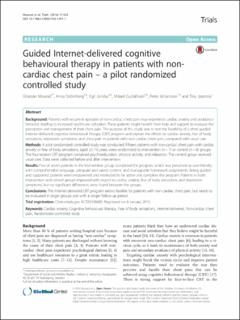| dc.contributor.author | Mourad, Ghassan | |
| dc.contributor.author | Strömberg, Anna | |
| dc.contributor.author | Jonsbu, Egil | |
| dc.contributor.author | Gustafsson, Mikael | |
| dc.contributor.author | Johansson, Peter | |
| dc.contributor.author | Jaarsma, Tiny | |
| dc.date.accessioned | 2020-04-27T08:20:46Z | |
| dc.date.available | 2020-04-27T08:20:46Z | |
| dc.date.created | 2016-12-07T12:14:51Z | |
| dc.date.issued | 2016 | |
| dc.identifier.citation | Trials. 2016, 17:352 (1), . | en_US |
| dc.identifier.issn | 1745-6215 | |
| dc.identifier.uri | https://hdl.handle.net/11250/2652550 | |
| dc.description.abstract | Background
Patients with recurrent episodes of non-cardiac chest pain may experience cardiac anxiety and avoidance behavior, leading to increased healthcare utilization. These patients might benefit from help and support to evaluate the perception and management of their chest pain. The purpose of this study was to test the feasibility of a short guided Internet-delivered cognitive behavioural therapy (CBT) program and explore the effects on cardiac anxiety, fear of body sensations, depressive symptoms, and chest pain in patients with non-cardiac chest pain, compared with usual care.
Methods
A pilot randomized controlled study was conducted. Fifteen patients with non-cardiac chest pain with cardiac anxiety or fear of body sensations, aged 22–76 years, were randomized to intervention (n = 7) or control (n = 8) groups. The four-session CBT program contained psychoeducation, physical activity, and relaxation. The control group received usual care. Data were collected before and after intervention.
Results
Five of seven patients in the intervention group completed the program, which was perceived as user-friendly with comprehensible language, adequate and varied content, and manageable homework assignments. Being guided and supported, patients were empowered and motivated to be active and complete the program. Patients in both intervention and control groups improved with regard to cardiac anxiety, fear of body sensations, and depressive symptoms, but no significant differences were found between the groups.
Conclusions
The Internet-delivered CBT program seems feasible for patients with non-cardiac chest pain, but needs to be evaluated in larger groups and with a longer follow-up period. | en_US |
| dc.language.iso | eng | en_US |
| dc.publisher | BioMed Central | en_US |
| dc.rights | Navngivelse 4.0 Internasjonal | * |
| dc.rights.uri | http://creativecommons.org/licenses/by/4.0/deed.no | * |
| dc.title | Guided Internet-delivered cognitive behavioural therapy in patients with non-cardiac chest pain - a pilot randomized controlled study | en_US |
| dc.type | Peer reviewed | en_US |
| dc.type | Journal article | en_US |
| dc.description.version | publishedVersion | en_US |
| dc.source.pagenumber | 12 | en_US |
| dc.source.volume | 17:352 | en_US |
| dc.source.journal | Trials | en_US |
| dc.source.issue | 1 | en_US |
| dc.identifier.doi | 10.1186/s13063-016-1491-1 | |
| dc.identifier.cristin | 1409446 | |
| dc.description.localcode | Open Access This article is distributed under the terms of the Creative Commons Attribution 4.0 International License (http://creativecommons.org/licenses/by/4.0/), which permits unrestricted use, distribution, and reproduction in any medium, provided you give appropriate credit to the original author(s) and the source, provide a link to the Creative Commons license, and indicate if changes were made. The Creative Commons Public Domain Dedication waiver (http://creativecommons.org/publicdomain/zero/1.0/) applies to the data made available in this article, unless otherwise stated. | en_US |
| cristin.ispublished | true | |
| cristin.fulltext | original | |
| cristin.qualitycode | 1 | |

